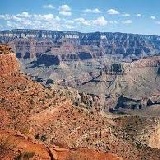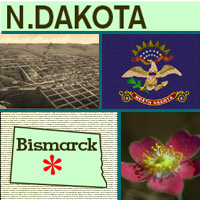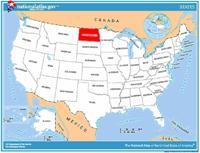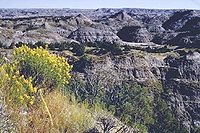|
Additional Lessons |
 About These
Lessons About These
Lessons
The following classroom lessons are great for students
who want additional listening and reading practice. |
-
Travel America -
Beginner
Level. Do you love America and American
English? Learn before you travel. Facts and other
cool stuff about your favorite U.S. state. Great
English reading practice.
|
 Travel
America - North Dakota Travel
America - North Dakota
(Beginner -
Reading)
Learn some interesting facts and read interesting
stories about North Dakota. |
 North
Dakota North
Dakota
Both rural and agricultural, with grain farms and
cattle ranches, North Dakota gets its name from the
Dakota division of the Sioux Indians who lived on
the plains before the Europeans arrived. "Dakota"
means "friend." French-Canadian soldier and fur
trader Pierre Gaultier de Varennes was the first
known white explorer to visit the home of the Dakota
in 1738. North Dakota was one of the last areas of
the frontier to be settled by non-Native Americans,
and even today, it's not a highly populated state.
North Dakota, whose capital is Bismarck, joined the
Union in 1889 as the 39th state. Appropriately, the
state flower is the wild prairie rose. |
North Dakota
State Flag
Adopted in 1911, the state flag of North Dakota
features a bald eagle holding an olive branch and a bundle
of arrows in its talons. The eagle carries a ribbon in its
beak saying "E Pluribus Unum" (Latin for "out of many, one")
symbolizing one nation made up of many states. A shield with
thirteen stripes on the eagle's breast represents the
original thirteen states.
The fan-shape with thirteen stars above the bald eagle is a
symbol for the birth of a new nation, the United States. The
name of the state - North Dakota - appears below the eagle
on a red scroll. The design is centered on a field of dark
blue.
The state flag conforms to the color, design, and size of
the regimental flag that was carried by North Dakota
Infantry in the Spanish-American War in 1898 and Philippine
Island Insurrection in 1899 (the only difference are the
words "North Dakota" on the scroll below the eagle).
In 1951 a state flag commission concluded that the flag "too
closely resembled the coat of arms of the United States and
that the flag was not symbolic of North Dakota," but this
conclusion was widely challenged and suggested changes to
the flag were rejected by North Dakota Legislature in 1953. |
|
Source:
State Symbols USA |
|
|
 North Dakota
State Facts North Dakota
State Facts
Picture: state seal of North Dakota |
|
State Capital |
Bismarck |
|
Nickname |
Peace Garden State / Flickertail State/ Sioux State |
|
Motto |
Liberty and Union, Now and Forever, One and
Inseparable |
|
Statehood |
November 2,1889 (39th or 40th -- Admitted the same
day as South Dakota) |
|
Origin of Name |
Dakota is the Sioux Indian word for "friend." |
|
Largest Cities |
Fargo, Bismarck, Grand Forks, Minot, Dickinson |
|
Border States |
Minnesota, Montana, South Dakota |
|
Area |
68,994 sq. mi., 17th largest |
|
State Bird |
Western Meadowlark |
|
State Flower |
Wild Prairie Rose (rosa arkansana) |
|
State Tree |
American Elm (ulmus americana) |
|
State Song |
North Dakota Hymn |
 Travel and tourism site
for North Dakota - This state travel and territorial
tourism site provides ideas for your vacations, meetings, and more. Travel and tourism site
for North Dakota - This state travel and territorial
tourism site provides ideas for your vacations, meetings, and more. |
|
|
North Dakota Stories |
|
|
United Tribes Powwow
Powwows are a way for Indian tribes to preserve their culture and
hand down traditions. They are Indian ceremonies or social
gatherings that include dance competitions and music. The United
Tribes Powwow in Bismarck, North Dakota, has been held every year
since 1969. The United Tribes are the five tribes in North Dakota:
the Spirit Lake, the Sisseton-Wahpton Sioux, the Standing Rock
Sioux, the Turtle Mountain Band of Chippewa, and the Three
Affiliated Tribes of Fort Berthold. Performers wear colorful outfits
of their tribe.
More than 1,500 traditional dancers perform to more than 40 drum
groups at the United Tribes Powwow. Women might perform the fancy
shawl dance. Dancers wear beautifully decorated shawls as they do
kicks and twirls. This dance is challenging because it requires fast
movements. Male dancers might perform the grass dance. A grass
dancer wears an outfit with long strands of fabric hanging off it.
He would also wear a roach, a kind of headdress with two feathers
that rock or twirl as he dances.
There is also an Indian Art Expo and Market at the powwow where
Indian artists gather to show their traditional work, such as
pottery, jewelry, beadwork, and paintings. |
|
|
Dakota Cowboy Poetry Gathering in Medora
When you think of cowboys, do you think of cattle drives, rodeos,
horses and -- poetry? Although poetry is not usually associated with
cowboys, in the 19th century, when cowboys worked on cattle drives
in the West, they would sit around the campfire at night and
entertain each other. They sang songs, told stories -- and recited
poetry. Cowboy poetry is usually about the work they do and their
connection with the land and animals. Some poems even tell a story.
They can be funny, sweet, or sad.
There are still cowboy poets today. Since 1987, cowboy poets have
met at the Dakota Cowboy Poetry Gathering in Medora, North Dakota.
The 50 or so participants who gather together every year keep the
tradition of cowboy poetry alive. |
|
|
North Dakota Winter Show
Are you a member of a club? If you were interested in farming and
agriculture, you might want to join the Future Farmers of America or
a local 4-H Club. Since the early 20th century, kids, such as those
in the photo, from rural or farming communities have often joined
one of these organizations. Even if you didn't know anything about
farming, you would learn a lot in these clubs because they believe
in "learning by doing." This means that students learn about
agriculture through doing such activities as growing a crop, raising
a calf, and using a tractor.
Members of 4-H Clubs and Future Farmers of America participate in
state fairs and other events and agricultural shows. The North
Dakota Winter Show started in 1937. The show is a major event in the
state -- 70,000 people attend each year. There are livestock shows,
competitions, and sales, as well as home-grown food and home-made
crafts. The North Dakota Winter Show is a great place for students
to learn about agriculture. |
|
|
Fort Seward Wagon Train
Do you know what a wagon train is?
During the 19th century, settlers in the United States who wanted to
move out West usually traveled by covered wagons in large groups.
People would meet in the early spring to hire guides, elect leaders,
and gather supplies before leaving on their journey as a wagon
train.
Every summer, more than 100 people meet at Fort Seward, near
Jamestown, North Dakota, to re-enact the wagon train experience and
live like pioneer families. For a week, they travel in
canvas-covered wagons pulled by mules or workhorses. A "chuck" wagon
provides their meals. Everyone dresses in late-19th century-style
clothing. Women wear long dresses, aprons, and bonnets, and men wear
vests and suspenders. Every night, the wagons circle around a
campsite, and trail riders share stories, music and crafts, just as
the early American pioneers did over a century ago. |
|
|
The Story of Sacagawea
Do you know the story of Sacagawea, the woman who is on the new $1
gold-colored coin?
Sacagawea belonged to the Shoshone tribe. In 1800, when she was 12
years old, Hidatsa warriors raided her tribe and captured many young
people, including Sacagawea. The Hidatsa, an American Plains Indian
tribe related to the Sioux, were traditionally a sedentary people,
meaning they established villages rather than travel around from
place to place. They lived in earthen lodges and traded with other
Plains tribes and English and French traders. Hidatsa men and women
each had clearly defined tasks and responsibilities. Men hunted
bison and other game and went to war. Along with maintaining the
lodges, women did most of the farming and grew corn, squash, and
beans. During the 19th century, Hidatsa warriors often went on
raiding parties like the one where they captured Sacagawea.
Sacagawea lived with the Hidatsa for a few years, but, by 1804, she
had been sold or gambled away to a French-Canadian trapper and
trader, Toussaint Charbonneau. Sacagawea became one of Charbonneau's
wives and gave birth to their son, Jean Baptiste. When explorers
Meriwether Lewis and William Clark passed through what is now North
Dakota in 1805, Charbonneau and Sacagawea joined their expedition.
Sacagawea went on to become the explorers' celebrated guide and
interpreter on their journey to the Pacific Ocean. |
|
|
Fort Ransom Sodbusters Association: Pioneer
Life
If you've ever wondered what it would have been like to live on a
farm in the early 1900s, you could get a good idea by going to
Sodbuster Days, a two-day event held at Fort Ransom State Park in
North Dakota.
The Fort Ransom Sodbusters Association, an organization that
celebrates and preserves pioneer life in Fort Ransom, North Dakota,
organizes Sodbuster Days and an annual rodeo.
During Sodbuster Days visitors can see what farm life was like
before electricity. They can watch demonstrations of elevating
grain, sawing wood, grinding corn, and pumping water. They can also
watch blacksmiths at work and see how a rim is put on a wagon wheel.
Traditional arts, crafts and foods from pioneer life are also
exhibited. Visitors can learn about quilting and soap-making.
In the rodeo, cowboys and cowgirls participate in calf roping, bull
or bronco riding, and steer wrestling. In calf roping, the
contestant has to rope up three of a calf's feet as fast as he or
she can. In the riding events, one has to stay on the bull or bronco
(an "unbroken" horse that resists training and bucks, or throws, its
rider) for eight seconds. That's what the rider in the photograph is
attempting to do! |
|
|
100th Annual Celebration by Icelanders
If the United States government offered you free land, would you
take it? Thousands of people did when the government passed the
Homestead Act in 1862. This act offered settlers 160 acres of free
public land in the Midwest if they lived on and cultivated it for at
least five years. This law was one of the reasons why so many
immigrants moved as far west and north as North Dakota in the last
half of the 19th century.
The immigrants who moved west came from many parts of Europe. Most
of them were Norwegian and German, but they also came from such
countries as Sweden, Ukraine, England, Finland, and Iceland. By
1915, 79 percent of all people living in North Dakota were either
immigrants or the children of immigrants.
North Dakota residents like to celebrate their diverse ethnic
heritage. For instance, in 1999, the town of Mountain honored its
Icelandic cultural legacy by throwing its 100th Annual Celebration
by Icelanders. More than 10,000 people from the United States,
Canada, and Iceland, including the President of Iceland, came to
celebrate. The festival's parade included a replica of a Viking
ship. |
|
Source:
Library of Congress |
|
 National Parks of North
Dakota National Parks of North
Dakota
The following is a description of national
parks in the state
of North Dakota. There are no national
forests or monuments in this state. If you plan to visit or
live in North Dakota for awhile then you
should definitely plan to visit some of
these fantastic places. |
|
|
|
National Parks |
 Theodore
Roosevelt Theodore
Roosevelt
This region that enticed and influenced
President Theodore Roosevelt consists of a
park of three units in the northern
badlands. Besides Roosevelt's historic
cabin, there are numerous scenic drives and
backcountry hiking opportunities. Wildlife
includes American bison, pronghorn, bighorn
sheep, and wild horses. |
|
|
Travel America |
|
|
Theodore Roosevelt National Park
(Beginner - Listening,
reading)
A video lesson which shows you an interesting place in America.
The English is
spoken at 75% of normal speed.
Great English listening and reading practice.
This video is all about Theodore Roosevelt National Park. |
|
 Travel
America Travel
America
Do you love America and American English? Learn before
you travel. Facts and other cool stuff about your
favorite U.S. state. Visit the Fun Easy English Travel
America pages. Read about the beautiful National
Forests, Parks, and Monuments. Great English reading practice. |
 Drive America Drive America
Planning to drive in America? Learn the rules and
regulations. Great English reading practice. |
|